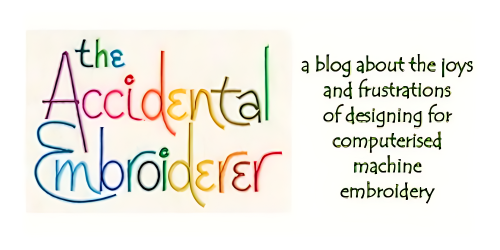Silver leaf vs. Mylar
Cherri’s sent me some samples of Mylar (from http://www.heirloomsbysharon.com/) and I’ve finally been able to try it out. I stitched the same fish with the Mylar as I had done before with the foil, and I’m pleasantly surprised. I had expected the foil to look a lot better, but in many ways the Mylar wins. For a start, because the Mylar isn’t glued down, it looks a bit “puffy”, which gives a nice three-dimensional look to the designs. The foil does looks a bit more genuinely metallic and less plasticky, but on the other hand the Mylar is a lot easier to use, and it doesn’t shed those worrying flakes. As I suspected, both materials have their advantages and disadvantages, and it's just a question of designing to make the most of whatever material you use
Fish embroidered with silver leaf
Fish embroidered with silvered Mylar film
Cherri's version of the Mylar fish in different colours
The only thing I really regret about giving up the foil is having to give up the fascinating colours and patterns it comes in. However the Mylar does come in some interesting colours too. I wonder if it would be possible to paint the Mylar with some very dilute acrylic paint to give a variegated appearance? I must give it a try
Meanwhile, with those technical problems sorted out, I think I can get back to the fish panel
